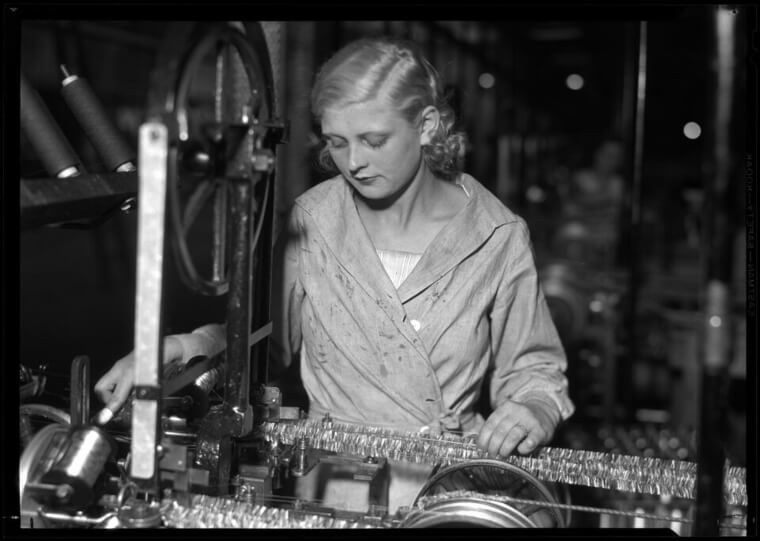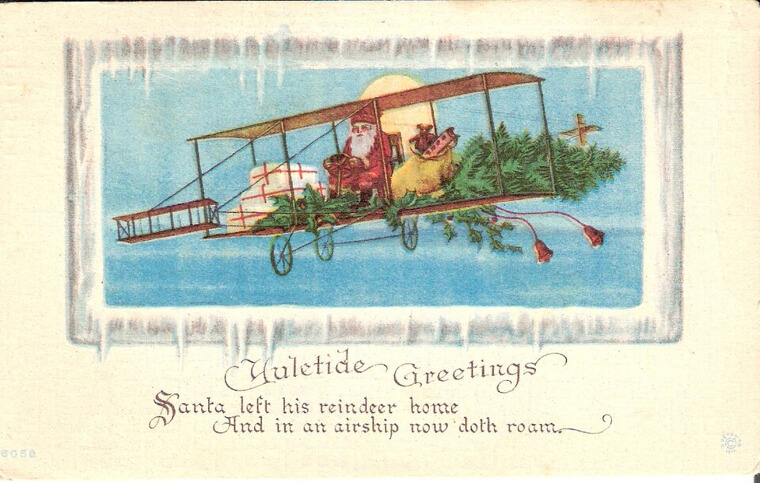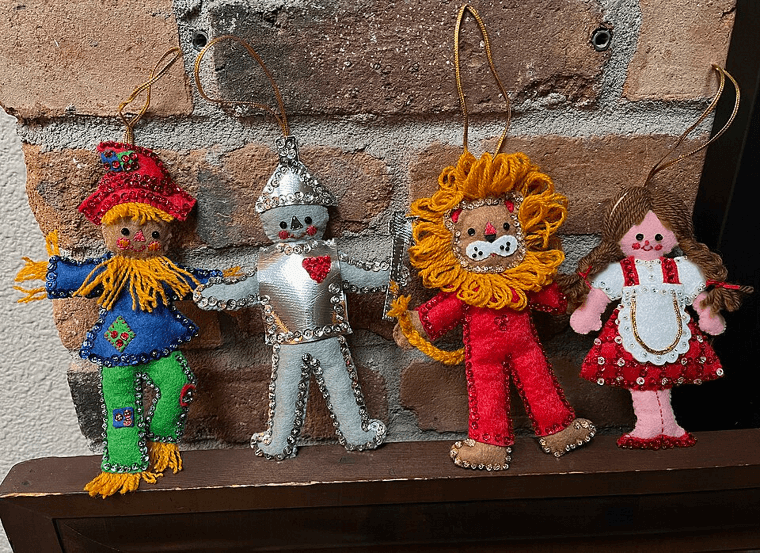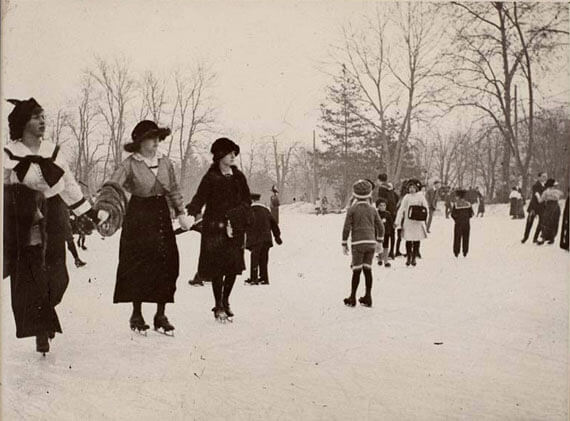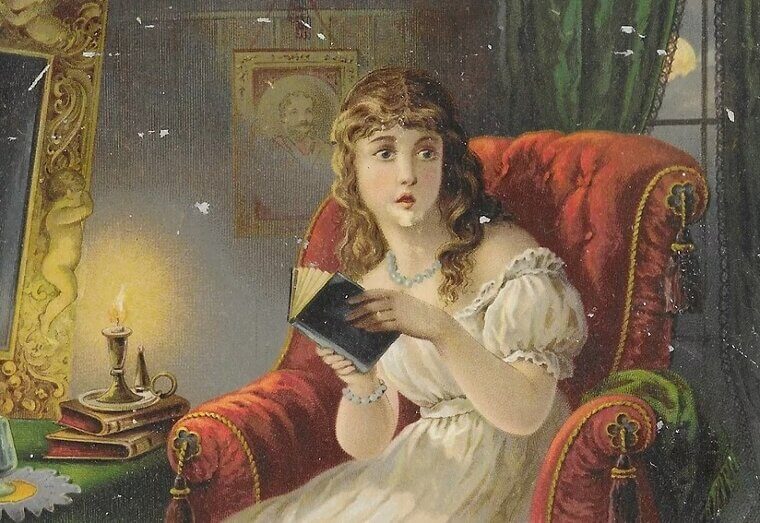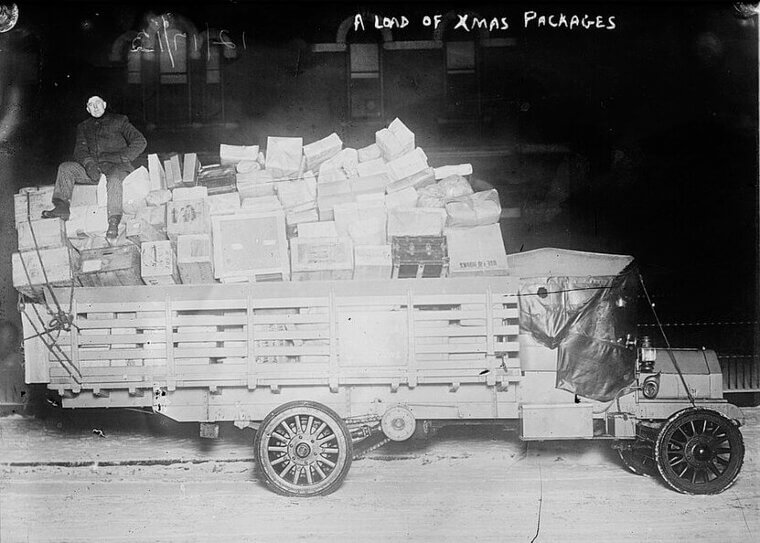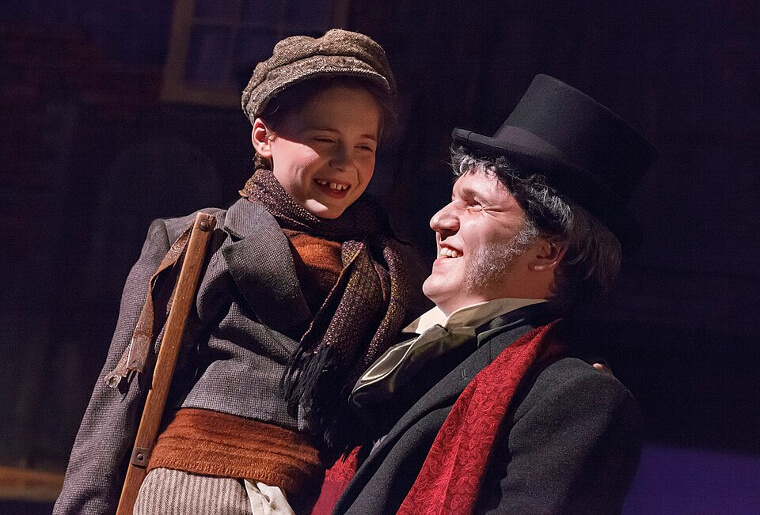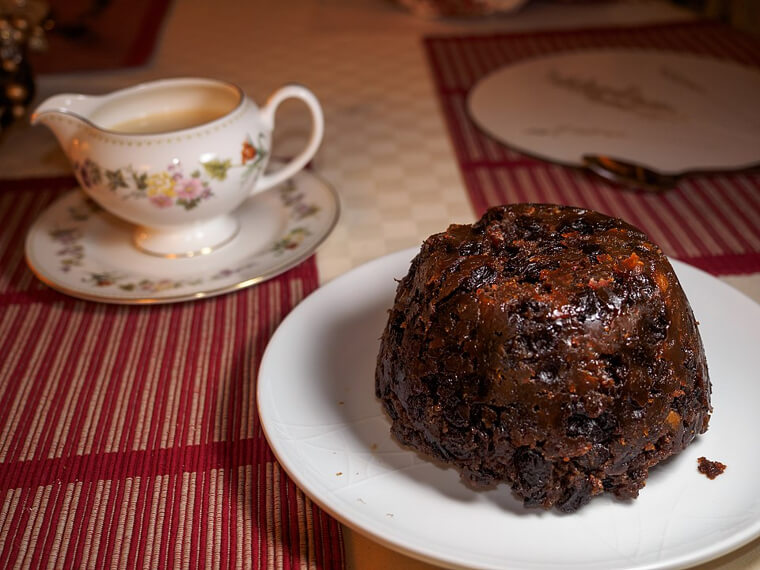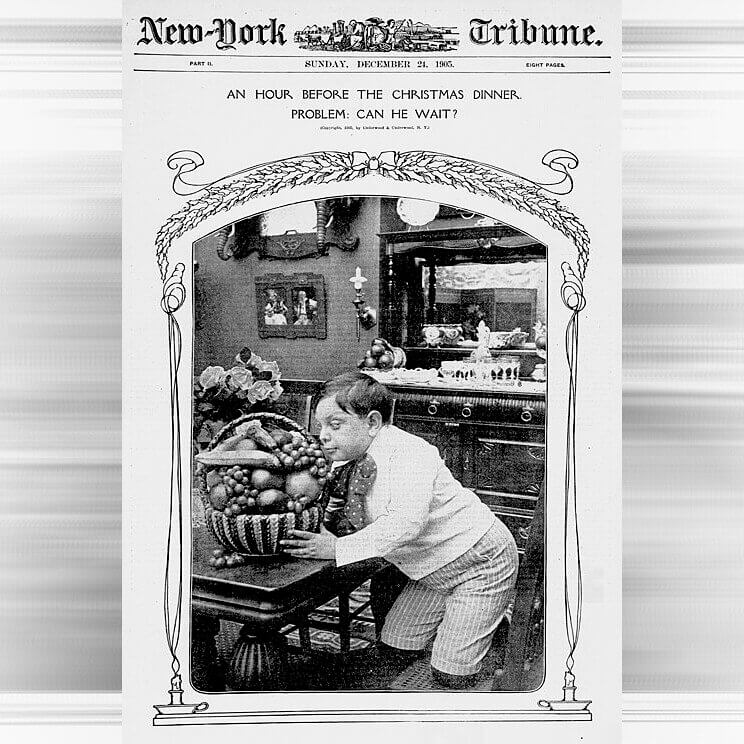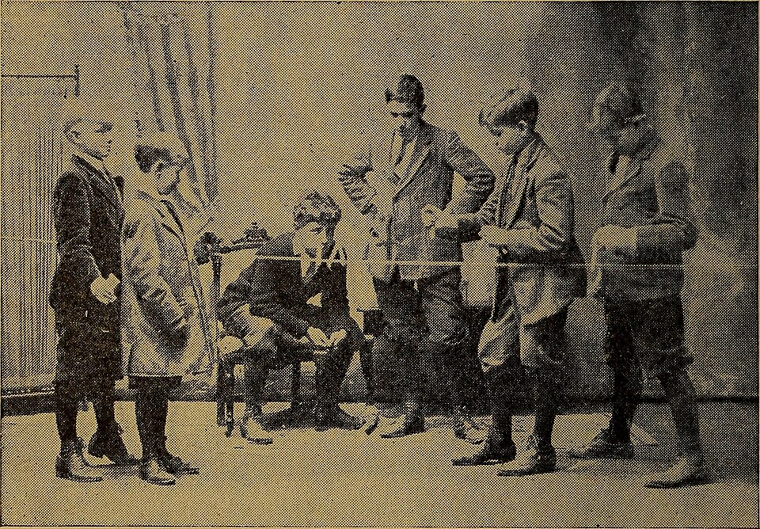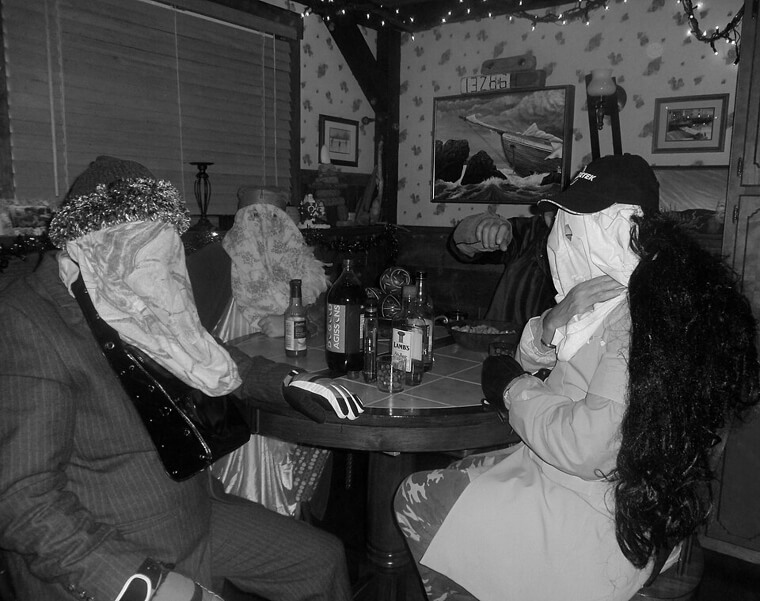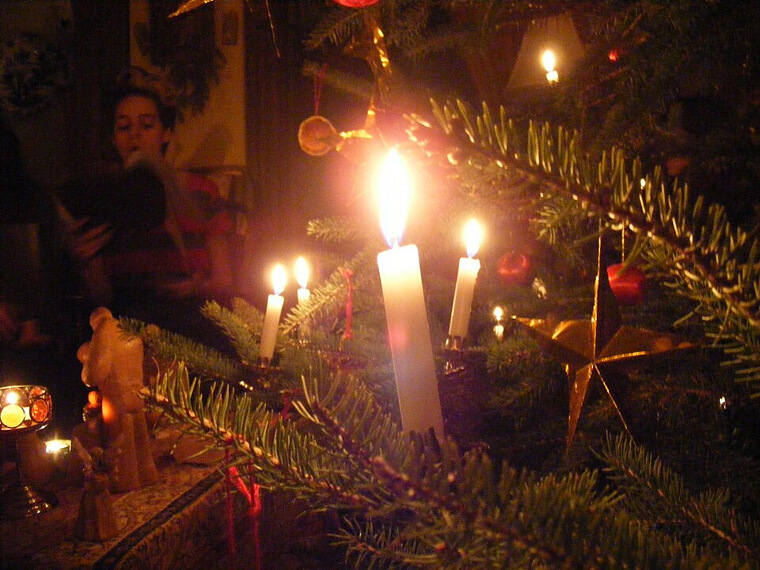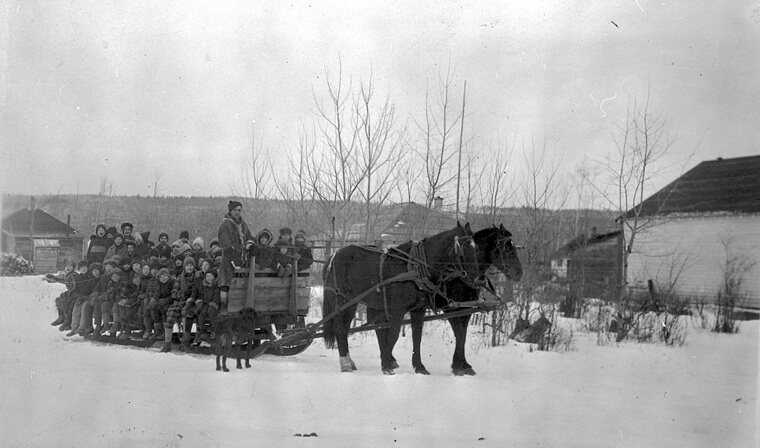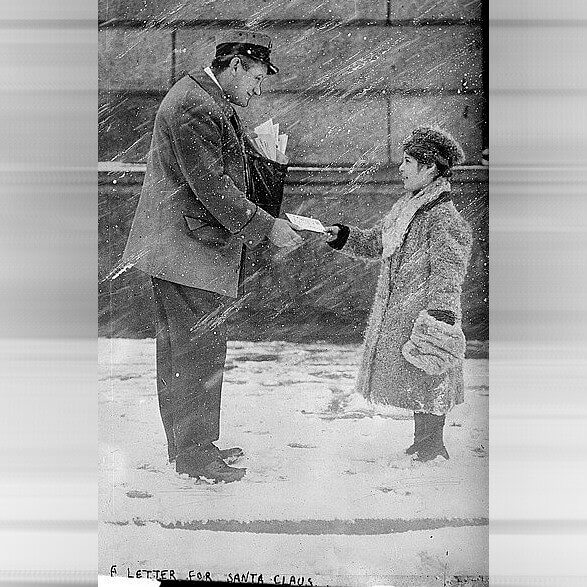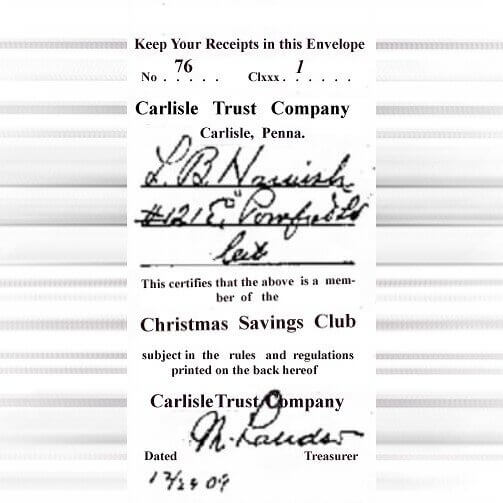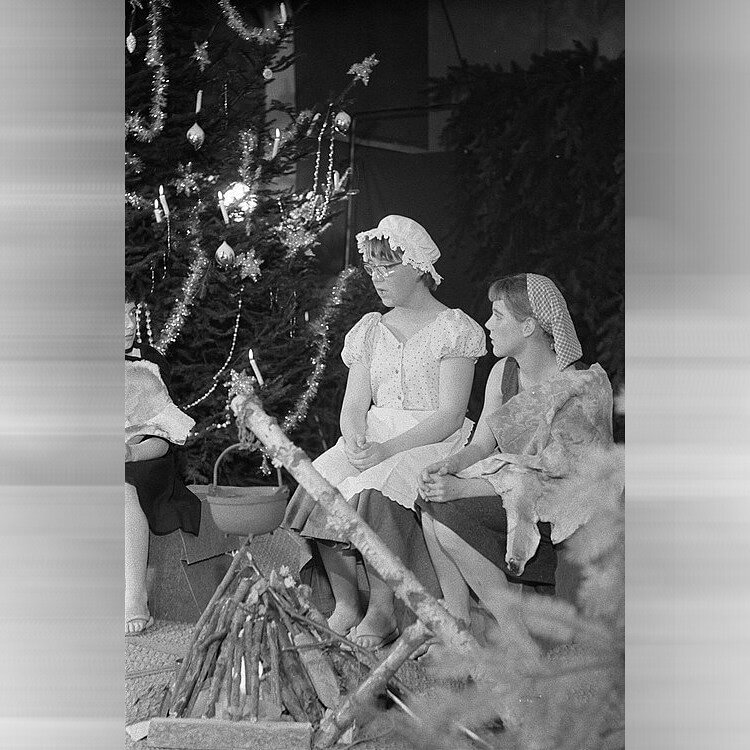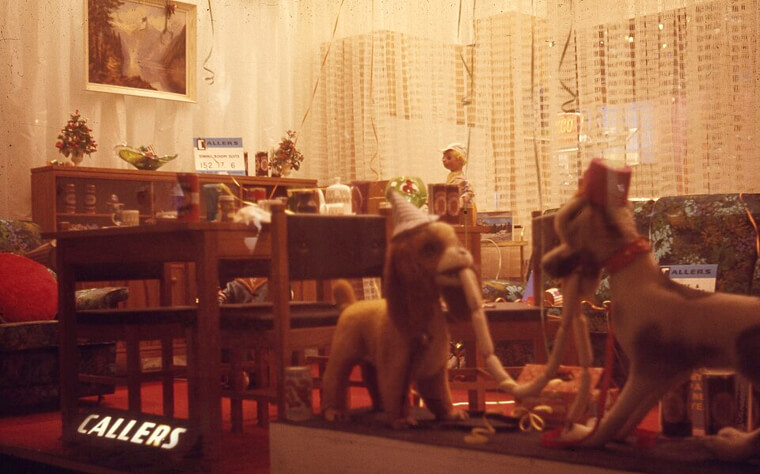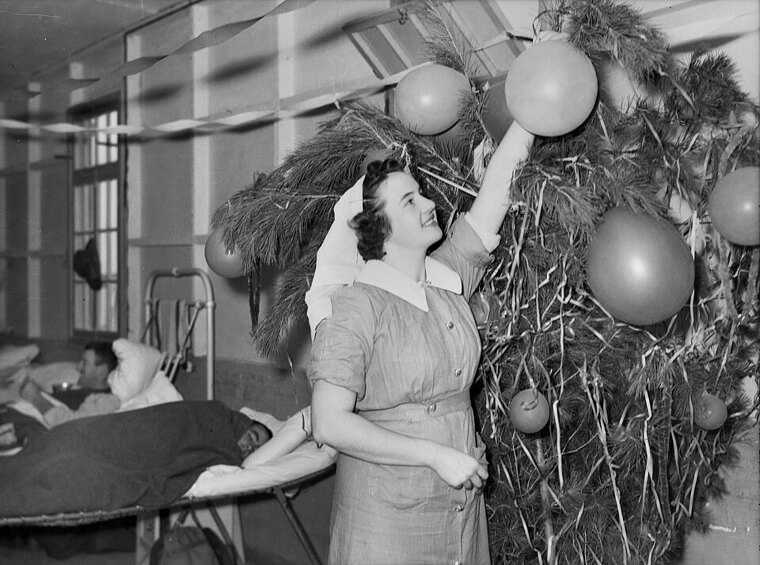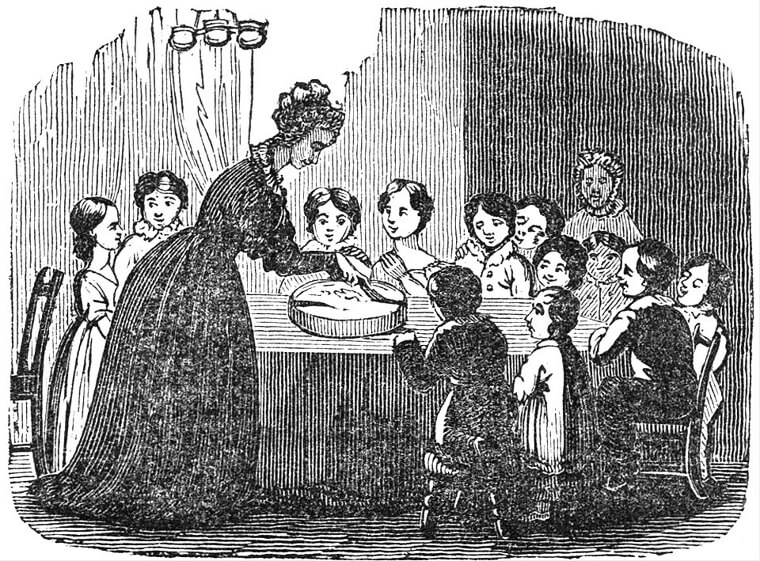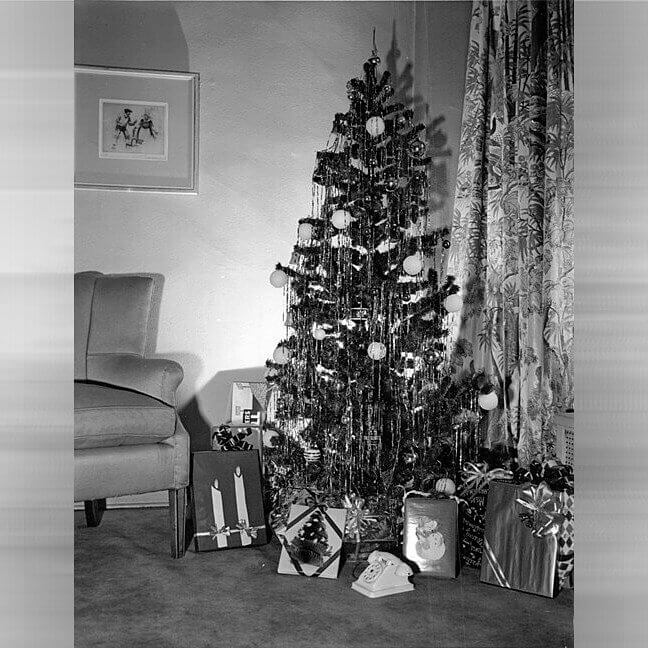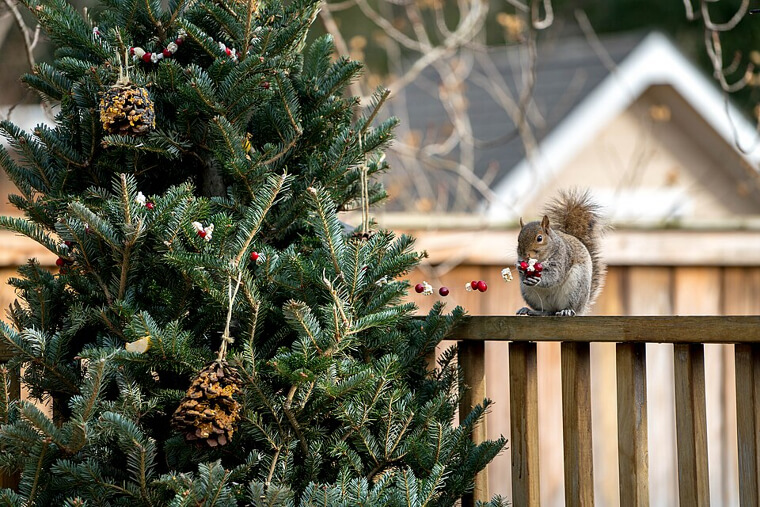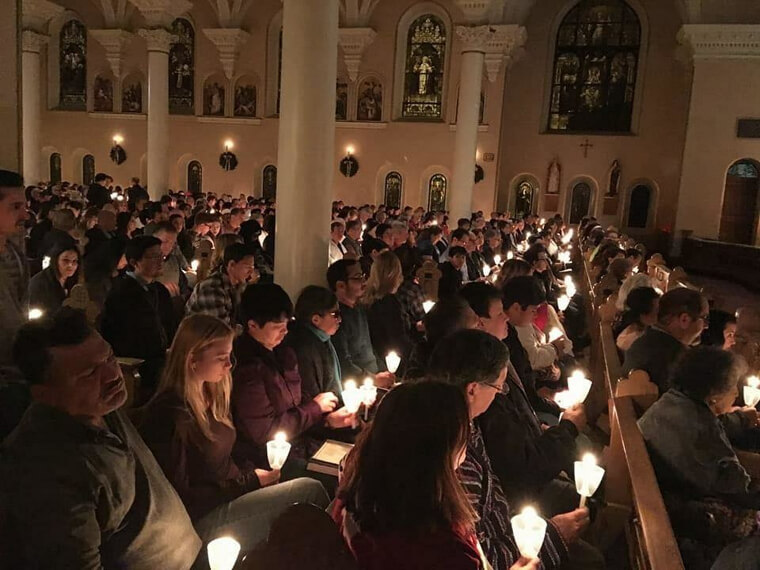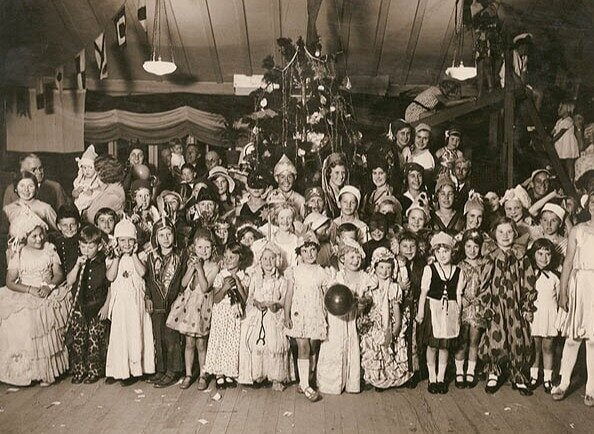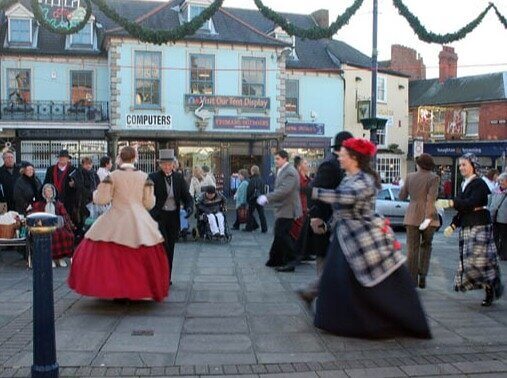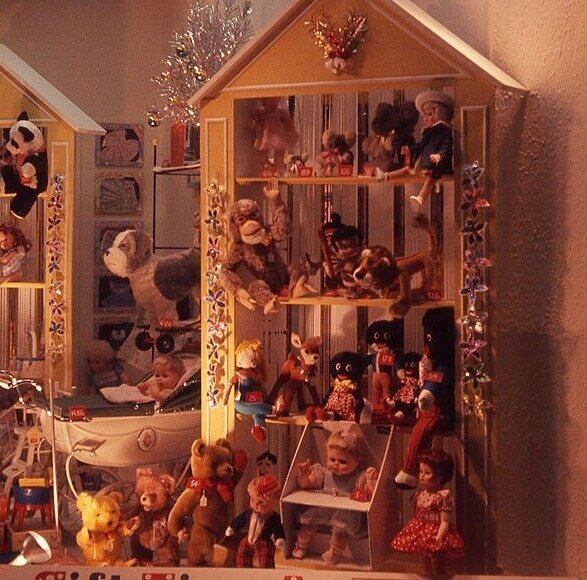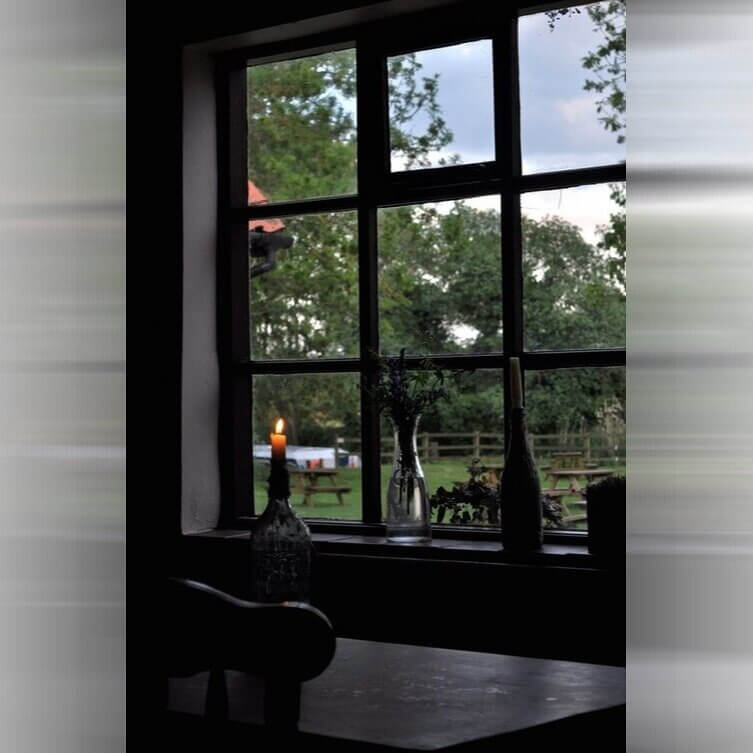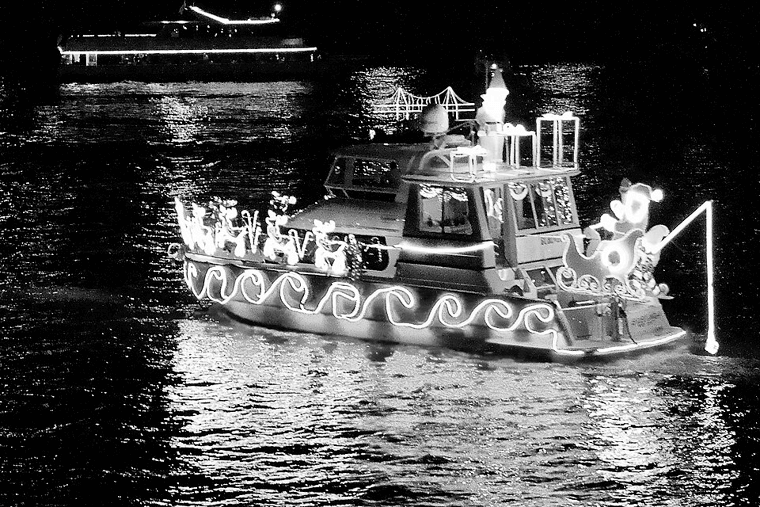Tinsel Used to Be Made of Real Silver
“Tinsel” originally meant thin strips of real metals, and, by the mid-twentieth century, many homes used lead tinsel icicles for shimmering trees. Lead made the strands heavy, so they draped beautifully—but posed health and environmental risks. Production and sales in the United States largely ceased by the 1970s as safety awareness rose. Lightweight PVC and mylar alternatives replaced metal tinsel, and many families eventually abandoned loose icicles altogether to avoid static cling and cleanup woes.
Today, metallic garlands or glittered ornaments create sparkle without scattering silvery threads. The gleam survives, but genuine metal strands are mostly history.
Illustrated Christmas Postcards
Before phones were common, families sent illustrated Christmas postcards rather than folded cards in envelopes. Picture postcards exploded between the 1890s and 1910s, featuring wintry scenes, Father Christmas, and hand-colored lithographs. Postcards were cheaper to mail than letters, and postal services delivered several times a day, so greetings often arrived quickly. As envelopes became standard, printers pushed folded greeting cards, which felt more formal and protected glitter or embossing.
Rising postal rates, changing tastes, and the dominance of boxed cards and digital messages gradually pushed the humble Christmas postcard into nostalgic, collector territory rather than everyday tradition.
Homemade Ornaments
For generations, tree decorations were handmade: paper chains, salt-dough shapes, tin stars, straw ornaments, and stitched felt figures. Families dried orange slices, folded origami, and reused ribbon or fabric scraps. After World War II, mass-produced glass baubles from Europe and later plastic ornaments from the United States and Asia became inexpensive, uniform, and durable. Department stores and catalogs promoted coordinated color schemes, nudging households away from mismatched, homemade looks.
Safety standards, busy schedules, and ready-made kits further accelerated the shift. While crafting hasn’t disappeared, the widespread, every-family practice of making most ornaments by hand largely faded.
The Yule Log
Historically, the Yule log was a large, carefully chosen hardwood log burned over several days, symbolizing warmth and good fortune during the darkest weeks. Families saved a piece to light the following year, and ashes were sometimes kept as charms against misfortune. This hearth-centered ritual declined as homes moved from fireplaces to stoves, radiators, and central heating.In many places, it transformed into a dessert—the bûche de Noël—or into televised “fireplace” programs that kept the cozy mood without actual embers.
The communal, slow-burning log itself, once a literal centerpiece, became a charming memory rather than a standard household custom.
Nature-Made Ice Rinks
Winter once meant skating on frozen ponds, canals, and flooded meadows, when sustained cold created natural rinks. Communities tested ice thickness, set lanterns, and organized races or socials outdoors. Over time, urbanization reduced accessible waterways, liability rules tightened, and weather patterns delivered fewer long, predictable freezes in many regions. Refrigerated indoor rinks and temporary synthetic surfaces now provide reliable ice without waiting for nature.
While some places still enjoy safe outdoor skating during cold snaps, the routine neighborhood practice of skating whenever the lake froze has diminished, replaced by scheduled sessions at maintained, permission-required facilities.
Telling Ghost Stories
In Victorian Britain, Christmas was a prime season for spooky tales. Long winter nights, candlelight, and family gatherings created the perfect mood for uncanny stories—think Charles Dickens’s “A Christmas Carol,” first published in 1843. Magazines routinely commissioned seasonal ghost stories, and parlors hosted dramatic readings for thrills between games and carols. As the twentieth century emphasized sentimental cheer, Santa, and commercial gift-giving, the spectral side of Christmas waned.
Radio, film, and television shifted ghost storytelling to Halloween or general entertainment. A few British broadcasts still nod to the tradition, but regular fireside ghost stories at Christmas are uncommon today.
Budget-Friendly Postal Services For Christmas
Victorian Britain’s Penny Post made sending seasonal greetings inexpensive and convenient, aided by multiple daily deliveries. Special Christmas postings and extra rounds helped millions of cards arrive before December 25. Over the twentieth century, postage rose, sorting modernized, and delivery frequency decreased. Royal Mail no longer offers the same density of daily rounds, and last-posting dates shifted earlier. Digital communication further reduced volumes.
While the UK still processes huge numbers of cards, the era when nearly every household relied on ultra-cheap postage and frequent deliveries specifically supporting Christmas card floods has passed, replaced by pricier stamps and online messages.
Caroling
Door-to-door caroling once brought neighbors together for harmonies, mulled drinks, and small donations for charities or church choirs. It thrived when neighborhoods were tight-knit, streets were quieter, and people expected unannounced visitors. Over time, more private lifestyles, busier roads, apartment intercoms, and security concerns made spontaneous house calls less comfortable. Organized concerts, indoor sing-alongs, and community events replaced rounds of doorstep serenades.
Streaming music, recorded carols, and school programs also reduced the need for live volunteers. Caroling survives in some towns and church groups, but the widespread, everybody-does-it custom of knocking on many strangers’ doors has largely faded.
Hidden Surprises In Pudding
In Britain and Ireland, Christmas pudding traditionally hid charms: a silver sixpence for prosperity, a ring for romance, or a thimble for thrift. Each bite offered a playful omen. As awareness of choking hazards grew and fewer people placed real coins in food, the practice declined. Metal charms also raised concerns about dental damage, allergies, and food safety regulations. Shop-bought puddings rarely include trinkets, and many modern hosts avoid the risk.
Some families still set a cleaned coin beside servings for luck instead. The playful divination remains a delightful story, but the surprise-in-the-slice ritual is no longer widespread.
Giving and Receiving Exotic Fruits
In the nineteenth century, oranges, pineapples, and other imported fruits were prized luxury gifts, symbolizing prosperity in winter. Shipping was slow, refrigeration limited, and prices high, so receiving a single orange in a stocking felt special. As global trade expanded and refrigeration improved, citrus became affordable and available year-round. The status signal disappeared, replaced by candies, toys, or tech. Pineapples moved from display centerpieces to supermarket produce sections.
Fruit baskets persist for hospitality or corporate gifting, yet the wonder of an orange at Christmas—once a treasured rarity—no longer resonates in everyday households accustomed to abundant, inexpensive fruit.
Christmas Crackers With Hand-Written Love Notes or Poems
Victorian and Edwardian crackers sometimes hid personalized slips—flirtatious verses, hand-written jokes, or tender sentiments—alongside paper hats and trinkets. As manufacturing scaled up, mass-printed jokes and standardized toys replaced bespoke messages. Busy hosts no longer wrote customized notes for each guest, and off-the-shelf crackers kept parties moving. Safety rules also discouraged anything flammable or messy inside. Modern premium crackers occasionally include nicer gifts, but hand-penned poems are rare.
The ritual of crafting intimate messages for each pull faded as parties grew larger and production industrialized, leaving the romance to nostalgia and the occasional lovingly assembled DIY set.
Christmas Games
Parlor games once anchored holiday evenings: charades, blind man’s buff, “forfeits,” and Snapdragon—plucking raisins from flaming brandy. These required little equipment, just guests and daring. As entertainment shifted to recorded music, radio, film, and later television, ready-made amusement replaced improvisational play. Safety worries also sidelined flame-centered games. Board games survived, but the specific Victorian set, with rhymes, forfeits, and theatrics, faded from regular practice.
Modern parties might revive a round for nostalgia, yet few families routinely dim lights and ignite a blue brandy flame. The social spirit persists; the exact games largely belong to history.
Mumming
Mumming—seasonal folk plays and costumed house-to-house performances—once appeared across parts of Britain, Ireland, and North America. Local troupes acted stock characters, fought mock battles, and passed the hat. Industrialization, urban living, and changing attitudes toward door-to-door performance reduced opportunities. Licensing rules, private property boundaries, and shifting entertainment tastes further eroded participation. Folk revivalists still stage mummers’ plays at festivals, but the custom as an expected neighborhood event has waned.
Instead of ad hoc midwinter pageants in kitchens and pubs, communities channel performance energy into school shows, church pageants, or organized theater with tickets, schedules, and permits.
Candles On the Tree
Before electric lights, people clipped real candles to branches for a brief, supervised glow. Families kept buckets of sand or water nearby and lit candles for only short periods. With the advent of safe, reliable electric strings in the late nineteenth and early twentieth centuries, open flames near dry needles quickly fell out of favor. Fire codes, insurance concerns, and common sense ended the practice in most homes.
Today’s LEDs mimic warm candlelight without scorch marks or risk. Occasional historical demonstrations remain, but the dramatic, perilous spectacle of flame-lit trees has wisely become a story rather than a norm.
Neighborhood Sleigh Rides
Horse-drawn sleighs gliding along snowy lanes were a real winter pastime where cold, open roads made it practical. As cars, plows, and salted pavement took over, snow-packed routes became rare, and stables moved farther from suburbs. Liability insurance and animal-welfare rules added costs. Today, sleigh rides survive mainly as booked attractions at farms or resorts when weather cooperates. City neighborhoods seldom expect jingling bells outside the door.
The imagery remains iconic—carols still sing about “one-horse open sleighs”—but the spontaneous community sleigh ride, organized by neighbors after a good freeze, largely ceded to organized, commercial, weather-dependent outings.
Handwritten and Mailed Letters To Santa
Children long addressed handwritten wishes to Santa, sometimes using the household chimney as a “mailbox,” or posting letters to special programs. Postal services in several countries still run charitable schemes—like USPS Operation Santa in the United States—but digital forms, emails, and app-based wish lists have grown. Parents often coordinate gifts through shared notes or online trackers instead. Schools and stores once hosted big letter-writing drives; now photo booths and email templates are common.
The tradition persists, yet the sheer volume of pen-on-paper letters traveling through the post has declined, replaced by quicker, screen-based ways to share wishes.
Christmas Savings Clubs At Local Banks
Beginning in the early twentieth century, Christmas clubs let depositors save small weekly amounts, receiving payout checks before December to fund gifts. They encouraged budgeting in a cash economy without credit cards. As banking modernized, interest rates changed, and revolving credit became widely available, dedicated holiday clubs lost appeal. Online savings tools, automatic transfers, and rewards cards supplanted passbooks and teller windows.
Some institutions still offer versions, but the once-prevalent ritual of opening a specific “Christmas Club” and collecting a printed check each autumn mostly disappeared, replaced by general savings accounts, budgeting apps, and year-round financial planning.
Family Nativity Plays
Home nativity plays—bedsheets for robes, cardboard crowns, and a doll for the baby—once featured after dinner, especially where church pageants were scarce. As schools, churches, and community theaters professionalized their productions, families shifted to attending scheduled performances. Video entertainment further replaced living-room dramatics, and smaller homes or apartments left little space. Dressing up survived for photos, but memorizing lines and staging scenes became rarer.
Today, children may participate in organized pageants, while the intimate, improvised family tableau has mostly faded, reappearing occasionally in nostalgic households or for social media clips rather than as an expected annual centerpiece.
"Twelve Days of Christmas" As a Memory Game
Cumulative songs once doubled as parlor memory games: each singer recited all prior verses without stumbling or paid a forfeit. “The Twelve Days of Christmas” fit perfectly, testing recall during long evenings. As formal parlor games declined and recorded music took over, the game aspect disappeared, leaving the carol as performance rather than participatory challenge. School concerts and radio play still feature the song, but few families gather to test memory with penalties for mistakes.
The tradition survives in spirit when groups ham it up, yet the structured, forfeit-based memory game is mostly a relic of earlier entertainment styles.
DIY Electric Decorations
Early electric enthusiasts once wired their own tree lights and window displays, experimenting with bulbs, sockets, and transformers. Magazines printed diagrams, and hardware stores sold parts. As standards improved, and electrical codes tightened, manufacturers offered sealed, certified, plug-and-play strings. DIY wiring—once a proud hobby—became risky and unnecessary. LED technology added controllers, app integration, and proprietary connectors, further discouraging homebrew rigs. Safety-conscious households prefer listed products over soldering near tinsel.
Makers still tinker with microcontrollers for light shows, but the mainstream custom of assembling household holiday lighting from discrete electrical parts is largely a bygone, replaced by boxed sets.
Celebrating January 5th As The End of Christmas
Traditionally, Twelfth Night—on January 5 in many reckonings—marked the festive season’s close, with decorations down the next day. In modern practice, many families return to work and school earlier, or pack away décor on New Year’s Day for convenience. Liturgical calendars still note Epiphany on January 6, but secular schedules dominate. Retail cycles also push “new year” resets and early Valentine’s displays.
The once-observed rituals of Twelfth Night cakes, wassailing, or final toasts have largely thinned out, surviving in select communities. For most households, Christmas now ends whenever routines resume, not by strict traditional count.
Choosing and Chopping Down Your Own Tree
Cut-your-own tree farms boomed in the mid-twentieth century, turning selection into a family outing with saws, cocoa, and roof-rack rides home. As artificial trees improved and urban living complicated transport and disposal, fewer households made the trek. Municipal rules on disposal, limited storage, and allergy concerns also nudged choices toward pre-cut lots or reusable trees. U-cut farms certainly remain, but they cater to enthusiasts willing to travel.
The default expectation that families will hike rows, measure trunks, and fell a favorite themselves has softened into an optional adventure rather than a near-universal December tradition.
Putting Candy Canes On the Christmas Tree
Candy canes once doubled as edible ornaments, dangling from branches until children claimed them. Early striped canes became closely associated with Christmas by the late nineteenth century. As central heating dried out trees faster, and as households introduced pets and toddlers to the mix, hanging sticky candy invited messes, ants, and cracked candy. Pre-lit trees, themed décor, and fragile glass or keepsake ornaments crowded out confections.
Health-conscious parents also preferred to limit sugar on display. Candy canes remain popular as treats and stocking stuffers, but using them as the tree’s everyday decorations isn’t nearly as common anymore.
Popcorn and Cranberry Garlands
Threading popcorn and cranberries into garlands added natural texture and color to trees and mantels. Families popped batches, let kernels stale for easier threading, and carefully pushed needles through. As artificial trees, themed ornaments, and pre-made garlands proliferated, the slow, fiddly craft lost ground. Concerns about attracting pests, staining furniture, or the garlands drying out also discouraged the practice. Ready-to-hang décor and busy schedules won out over needle-pricked fingers.
Some crafters keep the tradition alive for rustic looks or outdoor bird-friendly versions, but the once-common family activity of stringing bowls of popcorn has largely drifted away.
Candlelight Midnight Mass
Attending Midnight Mass exactly at midnight was once a hallmark in many Catholic and some Protestant communities. Over time, parishes shifted to earlier “late-evening” services to accommodate families, limited public transport, and safety concerns. Fire regulations, large congregations, and accessibility considerations reduced reliance on wax candles in crowded sanctuaries, swapping them for electric alternatives or brief symbolic use. Attendance patterns also changed as Christmas morning services multiplied.
Candlelit worship certainly survives, but the widespread, community-wide expectation of gathering precisely at midnight by candlelight has softened into varied service times with safer, more manageable lighting practices.
Holly and Ivy As Decor
Holly and ivy once dressed mantels and doorways, bringing evergreen life indoors with pagan-to-Christian symbolism about endurance and renewal. Gathering was local—hedgerows and gardens supplied the greens. Central heating dries foliage quickly, shedding berries and leaves, and urban living limited easy foraging. Artificial garlands, wreaths, and pre-lit décor replaced scratchy, short-lived branches. Allergies and pet safety—holly berries can be toxic—also discouraged real sprigs.
Florists still sell fresh bundles, but the everyday, practical choice moved toward long-lasting faux greenery. The look endures; the hands-on tradition of cutting and arranging prickly boughs at home is less common.
Ceremonial Traditions Surrounding the Mistletoe
Mistletoe carried layers of folklore—from ancient European rituals to later English customs where a “kissing bough” hung indoors. Traditions varied: removing a berry per kiss, or burning the sprig at season’s end to seal luck. Modern households often prefer simple décor without elaborate rules, and many workplaces discourage kissing customs entirely. Sourcing real mistletoe can be inconvenient, and artificial versions emphasize looks over ceremony.
The plant’s parasitic nature and berry toxicity also dampen enthusiasm in homes with pets or children. The symbol persists in songs and décor, but structured, rule-bound mistletoe ceremonies are largely historical footnotes.
Homemade Advent Calendars
Families once stitched, glued, or repurposed boxes to count down to Christmas, tucking in tiny notes, sweets, or chores. Today’s market offers everything from chocolate calendars to beauty minis and premium tea assortments. The convenience and novelty of themed, store-bought calendars overshadowed cottage crafting. Busy schedules, uniform packaging, and marketing cycles favor ready-made versions. Some crafters still design custom heirlooms, but the mainstream habit of assembling an Advent calendar at home each year, piece by piece, has declined.
The countdown tradition remains strong; what changed is the shift from personalized, homemade pockets to branded, prefilled doors.
Victorian Christmas Markets
Victorian-era markets mixed seasonal food, greenery, toys, and household goods in lively, often crowded streets. While modern European Christmas markets revived the festive concept with lights and mulled wine, the original Victorian experience—local butchers, coal-heated stalls, and everyday necessities alongside holiday wares—reflected a different economy. Refrigeration, supermarkets, and year-round shopping made once-seasonal items routine. Health and safety rules reshaped street trading, and permanent retail replaced many temporary setups.
Today’s markets echo the atmosphere, yet the distinctly Victorian mix and gritty practicality have faded, transforming from neighborhood provisioning to curated leisure events and tourism-oriented seasonal experiences.
Homemade Gifts
Handmade presents—knitted scarves, wooden toys, preserves, embroidered linens—were once necessities as much as gestures. Department stores, catalogs, and later e-commerce offered affordable, polished alternatives with reliable sizing and warranties. Time constraints and specialized skills made homemade gifts less practical for many households. Safety standards also sidelined certain DIY toys or cosmetics without testing. Crafting endures in niches—quilts, small-batch jams, or personalized art—but the expectation that most gifts under the tree will be homemade has faded.
Convenience, variety, and return policies pushed the balance toward purchased goods, leaving handmade items as heartfelt exceptions rather than the norm.
Candlelit Windows
Placing real candles in windows symbolized welcome and hope, especially in Irish and colonial American traditions. The custom required careful supervision to avoid fire and soot. As electricity spread, people adopted safer electric candles and later LED tapers with timers. Building codes, apartment rules, and concerns about curtains or blinds catching fire discouraged open flames. The visual survives in plug-in candles and projection lights.
But the nightly ritual of striking matches, monitoring drafts, and extinguishing real flames at bedtime is seldom practiced. The meaning remains; the medium changed to safer, longer-lasting illumination you can forget once it’s turned on.
Plum Porridge
Before plum pudding dominated, English households served plum porridge: a spiced beef or mutton broth thickened with bread, dried fruits (“plums”), and ale. Over time, recipes sweetened and solidified into boiled plum pudding, leaving porridge behind. Changing tastes favored richer desserts over meat-based soups for celebration meals. As Victorian puddings standardized with suet, flour, and steaming basins, the older savory-sweet bowl faded from holiday tables. Today, plum porridge appears mainly in historical cookbooks or reenactments.
Its warming spices foreshadow modern desserts, but the hearty, fruit-studded broth that once opened Christmas dinners has largely slipped from living memory.
Christmas Ships
In the late nineteenth and early twentieth centuries, decorated steamers and lake vessels sometimes carried trees and gifts to harbor towns. On the Great Lakes, Captain Herman Schuenemann’s “Christmas Tree Ship” delivered evergreens to Chicago until his death in 1912. Coastal parades of illuminated boats later evolved as civic spectacles. While a few regions still host boat parades, the practical tradition of ships distributing holiday necessities has vanished, replaced by trucking, air freight, and retail logistics.
Maritime pageantry survives, but the charitable, supply-bearing Christmas ship as a seasonal lifeline is now history, remembered through museum exhibits and commemorations.
Homemade Eggnog
Households once whipped eggs, sugar, milk, and cream by hand, sometimes folding in spirits and resting the mixture. Concerns about raw eggs, salmonella, and food safety made many cooks wary. Pasteurized, shelf-stable cartons appeared in groceries, offering consistent flavor without risk or labor. Specialty recipes linger—some use cooked custard bases or aged, alcohol-rich versions—but most people buy eggnog ready-made. Appliances reduced effort, yet convenience and safety won.
The seasonal toast remains, but the whisking, tempering, and carefully chilling of a family batch has become uncommon, shifted to culinary enthusiasts while the majority pour from cartons.
Victorian Penny Toys
Penny toys—cheap tin, lead, or celluloid novelties sold by street vendors—once filled stockings: tiny trains, whistles, spinning tops, and jointed figures. They thrived when small factories produced eye-catching items at rock-bottom prices. Safety standards, material changes, and rising production costs ended that era. Later toys required testing, packaging, and branding; small parts and toxic paints fell out of favor. Today’s equivalent might be party favors or capsule-vending trinkets.
But the distinctive, mass of Victorian penny toys—charming, flimsy, and sometimes hazardous—belongs to collectors and museums. Children’s stockings now hold safer, sturdier treats from thoroughly regulated manufacturers.
